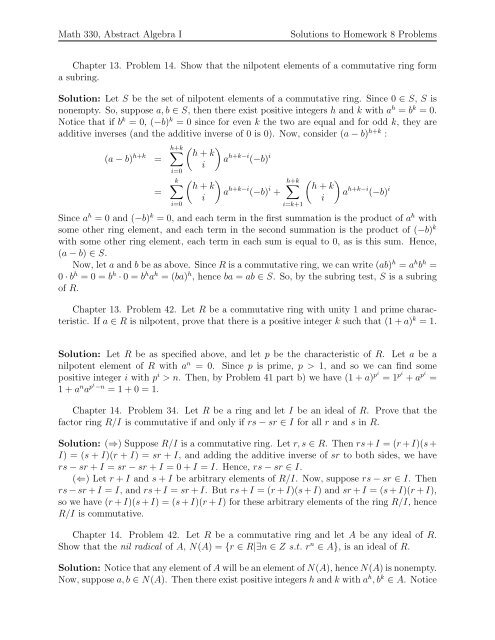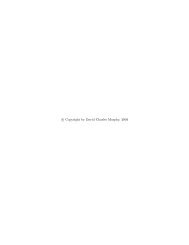Math 330, Abstract Algebra I Solutions to Homework 8 Problems ...
Math 330, Abstract Algebra I Solutions to Homework 8 Problems ...
Math 330, Abstract Algebra I Solutions to Homework 8 Problems ...
You also want an ePaper? Increase the reach of your titles
YUMPU automatically turns print PDFs into web optimized ePapers that Google loves.
<strong>Math</strong> <strong>330</strong>, <strong>Abstract</strong> <strong>Algebra</strong> I<br />
<strong>Solutions</strong> <strong>to</strong> <strong>Homework</strong> 8 <strong>Problems</strong><br />
Chapter 13. Problem 14. Show that the nilpotent elements of a commutative ring form<br />
a subring.<br />
Solution: Let S be the set of nilpotent elements of a commutative ring. Since 0 ∈ S, S is<br />
nonempty. So, suppose a, b ∈ S, then there exist positive integers h and k with a h = b k = 0.<br />
Notice that if b k = 0, (−b) k = 0 since for even k the two are equal and for odd k, they are<br />
additive inverses (and the additive inverse of 0 is 0). Now, consider (a − b) h+k :<br />
∑h+k<br />
( ) h + k<br />
(a − b) h+k =<br />
a h+k−i (−b) i<br />
i<br />
=<br />
i=0<br />
k∑<br />
i=0<br />
( h + k<br />
i<br />
)<br />
a h+k−i (−b) i +<br />
∑h+k<br />
i=k+1<br />
( ) h + k<br />
a h+k−i (−b) i<br />
i<br />
Since a h = 0 and (−b) k = 0, and each term in the first summation is the product of a h with<br />
some other ring element, and each term in the second summation is the product of (−b) k<br />
with some other ring element, each term in each sum is equal <strong>to</strong> 0, as is this sum. Hence,<br />
(a − b) ∈ S.<br />
Now, let a and b be as above. Since R is a commutative ring, we can write (ab) h = a h b h =<br />
0 · b h = 0 = b h · 0 = b h a h = (ba) h , hence ba = ab ∈ S. So, by the subring test, S is a subring<br />
of R.<br />
Chapter 13. Problem 42. Let R be a commutative ring with unity 1 and prime characteristic.<br />
If a ∈ R is nilpotent, prove that there is a positive integer k such that (1 + a) k = 1.<br />
Solution: Let R be as specified above, and let p be the characteristic of R. Let a be a<br />
nilpotent element of R with a n = 0. Since p is prime, p > 1, and so we can find some<br />
positive integer i with p i > n. Then, by Problem 41 part b) we have (1 + a) pi = 1 pi + a pi =<br />
1 + a n a pi−n = 1 + 0 = 1.<br />
Chapter 14. Problem 34. Let R be a ring and let I be an ideal of R. Prove that the<br />
fac<strong>to</strong>r ring R/I is commutative if and only if rs − sr ∈ I for all r and s in R.<br />
Solution: (⇒) Suppose R/I is a commutative ring. Let r, s ∈ R. Then rs + I = (r + I)(s +<br />
I) = (s + I)(r + I) = sr + I, and adding the additive inverse of sr <strong>to</strong> both sides, we have<br />
rs − sr + I = sr − sr + I = 0 + I = I. Hence, rs − sr ∈ I.<br />
(⇐) Let r + I and s + I be arbitrary elements of R/I. Now, suppose rs − sr ∈ I. Then<br />
rs − sr + I = I, and rs + I = sr + I. But rs + I = (r + I)(s + I) and sr + I = (s + I)(r + I),<br />
so we have (r + I)(s + I) = (s + I)(r + I) for these arbitrary elements of the ring R/I, hence<br />
R/I is commutative.<br />
Chapter 14. Problem 42. Let R be a commutative ring and let A be any ideal of R.<br />
Show that the nil radical of A, N(A) = {r ∈ R|∃n ∈ Z s.t. r n ∈ A}, is an ideal of R.<br />
Solution: Notice that any element of A will be an element of N(A), hence N(A) is nonempty.<br />
Now, suppose a, b ∈ N(A). Then there exist positive integers h and k with a h , b k ∈ A. Notice
<strong>Math</strong> <strong>330</strong>, <strong>Abstract</strong> <strong>Algebra</strong> I<br />
<strong>Solutions</strong> <strong>to</strong> <strong>Homework</strong> 8 <strong>Problems</strong><br />
that if b k ∈ A, so is (−b) k since for even k, (−b) k = b k and for odd k, (−b) k = −b k , and A<br />
is closed under additive inverses. Now, consider (a − b) h+k :<br />
(a − b) h+k =<br />
=<br />
∑h+k<br />
( ) h + k<br />
a h+k−i (−b) i<br />
i<br />
i=0<br />
k∑<br />
i=0<br />
( h + k<br />
i<br />
)<br />
a h+k−i (−b) i +<br />
∑h+k<br />
i=k+1<br />
( ) h + k<br />
a h+k−i (−b) i<br />
i<br />
Notice that every term in the first summation is the product of a h with some other ring<br />
element and every term in the second summation is the product of (−b) k with some other<br />
ring element. Since A is an ideal of R and we know a h ∈ A and (−b) k ∈ A, we know that<br />
every term in each summation is contained in A, hence the sum itself is contained in A.<br />
That is, (a − b) h+k ∈ A, hence a − b ∈ N(A).<br />
Now, for a ∈ N(A) and some arbitrary element r ∈ R, we know that there is some<br />
positive integer h with a h ∈ A. Since R is a commutative ring, we can write (ar) h = a h r h =<br />
r h a h = (ra) h , which we know is an element of A, since a h ∈ A and A is an ideal. So, by the<br />
ideal test N(A) is an ideal of R.<br />
Chapter 14. Problem 56. Let R be a commutative ring with unity and let I be a proper<br />
ideal with the property that every element of R that is not in I is a unit of R. Prove that I<br />
is the unique maximal ideal of R.<br />
Solution: Let R and I be given as above. Suppose A is an ideal of R with I ⊂ A ⊆ R (so<br />
that I is properly contained in A). Then there is some element a ∈ A, a ∉ I. Since a ∉ I, a<br />
must be a unit. So there is some a −1 ∈ R, and the product of this ring element with a must<br />
be contained in the ideal A: a · a −1 = 1 ∈ A. Since 1 is an element of A, A = R, hence I is<br />
maximal.<br />
Now, suppose B ≠ I is a maximal ideal of R. As B is maximal and B ≠ I, B is not a<br />
subset of I (for then B I R implies that B is not maximal). Thus there must be an<br />
element b ∈ B so that b ∉ I, hence b is a unit. By the above argument, we see that B must<br />
in fact be all of R, as B contains 1. Hence, B is not actually a maximal ideal, and I is, in<br />
fact, the unique maximal ideal of R.

















